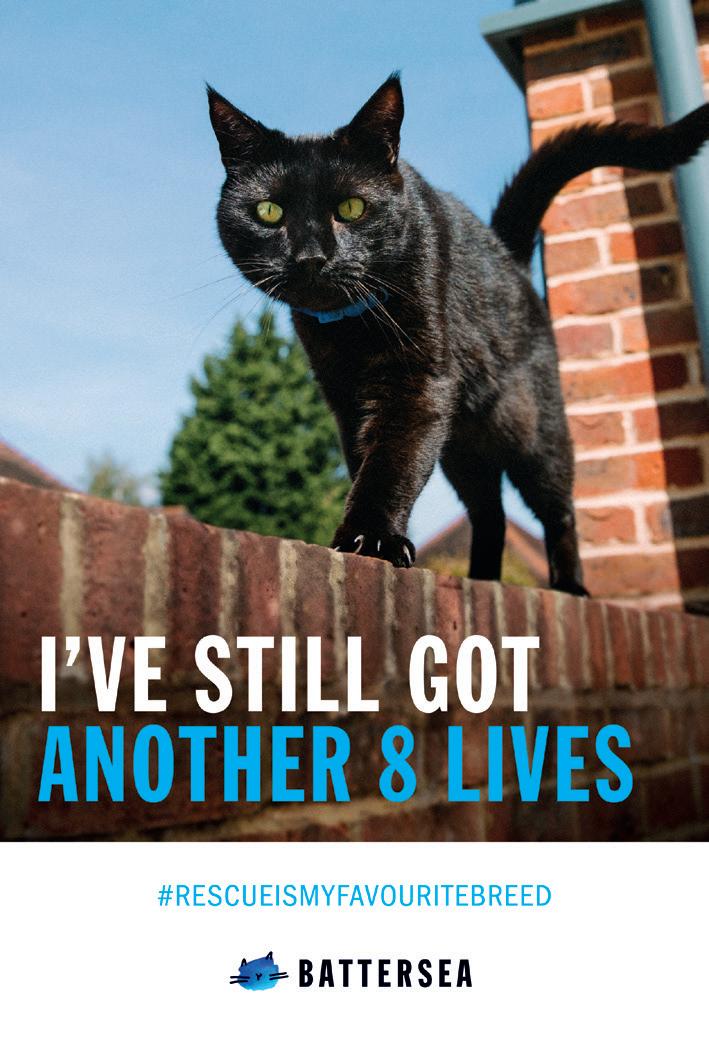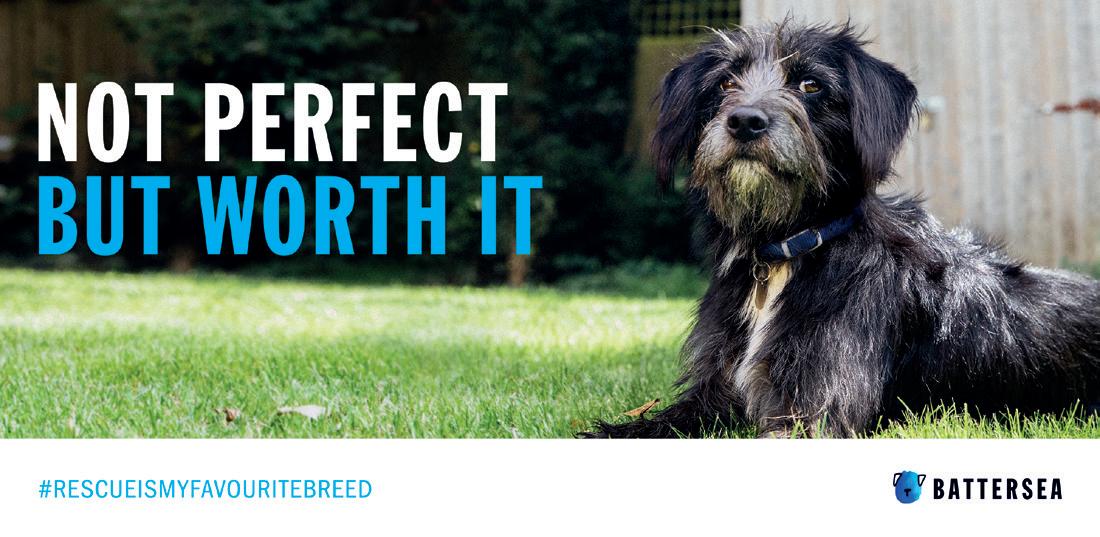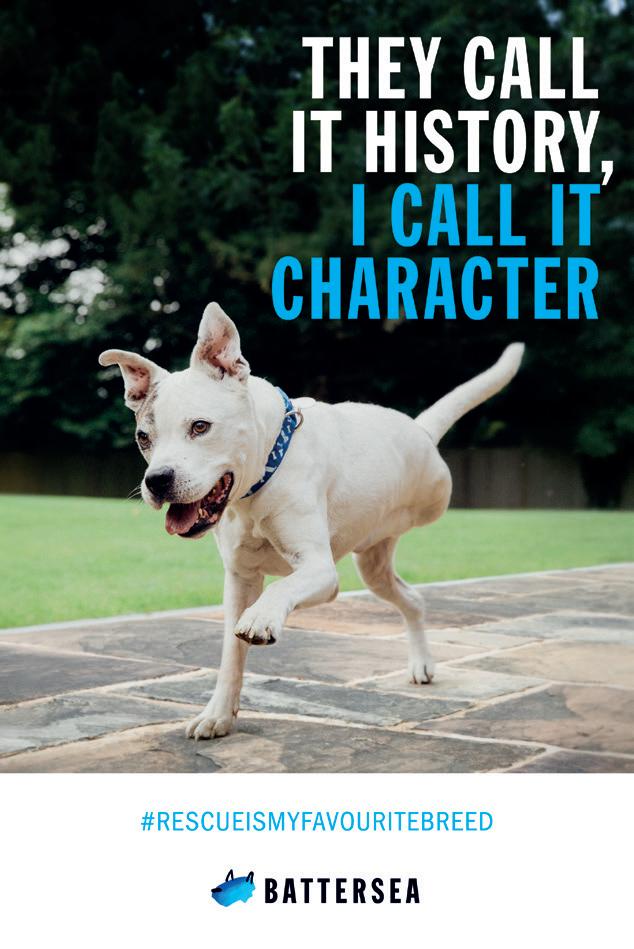
8 minute read
Rescue mission
By Ali Catterall
Battersea Dogs & Cats Home needed a pawsitively purrfect campaign to change attitudes about rehoming rescue animals
Advertisement
It’s often said that we Brits are a nation of animal lovers, and the numbers certainly bear that out. Nationwide, we happily cohabit with 9 million dogs and 8 million cats.
However, life can still be tough for some of our furry friends – particularly rescue animals. Each year, around 250,000 unwanted or neglected pets arrive at rescue centres around the UK, including that national treasure, Battersea Dogs & Cats Home.

BATTERSEA’S KEY MESSAGING FOCUSED ON CHALLENGING SOME OF THE REASONS WHY PEOPLE CHOOSE NOT TO REHOME
Over its 160-year history, the charity has rescued and rehomed more than 3.1 million cats and dogs, lovingly pairing them up with carefully vetted humans. But that’s not before they’re given the full service: a thorough veterinary check (and surgery if needed), vaccinations, neutering and microchipping.
These animals come “in all shapes and sizes,” Battersea notes, and “refuse to be defined by their past”. After all, “rescues aren’t broken, or damaged… and while they may not look perfect, they have so much to give”.
FORGOTTEN FAVOURITES
Sadly, rescues aren’t always people’s default choice of pet. Plenty of people now take to the internet to search for designer and fashionable breeds such as French bulldogs – in 2019, there were 165,000 monthly online searches for the breed – and Battersea has been quick to spot a reduction in rehoming. Rescue animals are being left behind.
“Even though one in four dogs and cats are rescues, you’re still more likely to hear about French bulldogs or labradors being the nation’s favourite pets,” says Battersea’s chief executive Claire Horton. “Our preoccupation with breed is fuelling a ruthless pet trade based on looks alone – one that can sadly put profit before animal welfare.”
Research by Battersea shows that a whopping 92% of people believe that getting a rescue cat or dog is the right thing to do. And yet just 25% of people have actually put their money where their mouth is. Excuses include that they “can’t get the type of breed they want from a rescue centre”, that they think rescue animals have health or behavioural problems, and that “you don’t know their full history”.
Battersea decided to do something about this. Launching a campaign, it hoped to change the way people think about rescue animals, celebrating their inimitable characters and quirky personalities rather than focusing on potential issues. Ultimately, the aim was to put the idea into the public’s minds that these animals could be owned by “people like me”, while encouraging potential owners to think “rescue” first and “breed” second when it comes to finding their new pet – even if that means waiting a little longer to find the perfect match. Potential owners would be told to look beyond pedigree and “instead see character”. And Battersea wanted to do all this in a long-lasting way that would cause a generational shift in perception and a measurable change in behaviour.
Apart from the bias towards buying designer breeds, research showed that the biggest obstacle to rehoming rescue animals was a fear of the unknown. Battersea’s long-term campaign hoped to break down these fears and dispel the myths, encouraging potential owners to see “rescue” as a badge of honour.
“People think rescue dogs or cats will be harder to train than a new puppy or kitten, or that it’s just not as prestigious to own a pet that hasn’t come from a breeder,” says Rob Young, Battersea’s head of operations. “Nothing could be further from the truth. Ask any proud rescue owner and they will tell you that rescue pets are the best pets. They may not be perfect, but they’re worth it.”
LIGHTS, CAMERA, AFGHAN
No one had ever attempted a campaign of this kind before within the rescue sector. But there were precedents to be found: Mind’s 2017 ReThink Mental Illness campaign and Sport England’s 2014 This Girl Can campaign had tackled similar long-term goals, for example.
So, in October 2019, the Rescue Is My Favourite Breed campaign was launched, led by creative agency FCB Inferno. The firm already had a good pedigree, having won awards for its campaigns for Barnardo’s and the Home Office. The year before, it had been named Agency of the Year at the inaugural Campaigns for Good Awards.

Battersea needed to find the perfect director to shoot the campaign ad too, someone skilled in bringing out the quirky side of animals onscreen. Step forward BAFTA- and Emmy-winning director Mateo Willis, whose CV features shows such as Blue Planet II, Planet Earth II and Frozen Planet. Having started his career as a cameraman, filming documentaries and commercials, he eventually trained his lens on the world of wildlife. The animal-loving filmmaker was a natural fit. Not least because he once had a dog from Battersea. “I already had great respect for their work, and I think the service they provide is frankly amazing,” he says.
As with all wildlife filming, Willis’ approach was to capture the energy and character of each animal. To do this, he explains, the viewer’s perspective has to be aligned with that of the animal in question – at their eye level, moving at their speed, creating a natural connection between subject and audience. “I wanted the dogs and cats to take centre stage,” he says.
Authenticity was key: wherever possible, ex-Battersea dogs were used in the campaign, and all the animals were former rescues. “To capture their characters, we needed to be reading their moods and predicting what they would most likely do, just as I do with wild animals,” says Willis. “And in both scenarios, it’s often the unscripted moments that are pure gold.”
The campaign kicked off with a concentrated, three-week burst of cross-channel activity, including TV, outdoor marketing, social, digital and PR. Most media activity (90%) focused on driving awareness to potential rehomers. Key indicators included a hashtag, #RescueIsMyFavouriteBreed, which generated scores of positive tweets. “Why spend silly money on a designer pet when there are so many wonderful cats and dogs in need of a good home in shelters,” tweeted writer Katherine Price. Model and Battersea ambassador David Gandy helped to get the word out on Instagram, and TV shows such as The X Factor and Gogglebox were roped in. High-visibility outdoor sites such as Waterloo Station in London carried eye-catching posters.
A HOWLING SUCCESS
Elsewhere, the campaign targeted those already in the market for a pet via sites such as Gumtree. A PR launch took place in October for the media, celebrities, influencers and friends of Battersea, resulting in 19 pieces of coverage, including an interview on BBC Radio London’s Barking Hour (with an audience of around 89,000) and placements in Coast magazine, The Sun and Channel 4’s Sunday Brunch.
Early reports indicated successful visibility, with one in five people recalling the campaign when prompted.

It generated an overwhelmingly positive social media reaction too, including a 1,112% month-on-month increase in the use of the #RescueIsMyFavouriteBreed hashtag during launch month. Visits to Battersea’s website also increased by 29% year-on-year during the campaign.
“It has been fantastic seeing the reception we’ve had to the campaign from animal lovers up and down the country,” says Deborah Chapman,

TAZZIE LOST HIS LEG AFTER BEING THROWN FROM A TOP-FLOOR WINDOW BY HIS PREVIOUS OWNERS
Battersea’s head of media & PR. “The hashtag has given proud rescue owners a great opportunity to shout about their wonderful rescue dogs and cats, helping us to increase the visibility of rescue and show off their unique quirks. Now more than ever, we’re seeing the great bond that exists between people and their pets, both in terms of the companionship they provide and also the joy they bring us.”
While there was no direct fundraising aspect to the campaign, Battersea hopes it will increase the charity’s visibility and strengthen its brand. It will also continue to share more stories of owners and their rescue pets, and by 2021 it hopes to have mobilised the existing rescue community, working with other rescue centres across the UK to grow and unite the movement.
Importantly, the charity has since removed breed filters from its own online animal galleries, in order to encourage potential owners to be more open to rescue pets and to look beyond specific breeds. Trials showed that when the option to filter by breed was removed, a higher percentage of website visitors went on to apply to rehome a pet.
“We know that misconceptions and preconceived notions about the traits and behaviours of certain dog and cat breeds can heavily influence people’s rehoming choices,” says Young. “By removing the option to search by breed, we’re hoping that visitors to our website will be more open-minded to finding the right match. If someone is looking for an affectionate lap dog, or an energetic, playful pet, then they will find a perfect match regardless of breed. When you go to Battersea, you won’t just get a ragdoll or a labrador or even a mongrel. Most importantly, you’ll be getting a rescue.”
The last woof goes to Belle, a threeyear-old rescue lurcher from Tonbridge, Kent, who featured in the campaign. As owner Giovanna Trani-Brown explains: “People may have reservations about visiting a rescue centre, thinking that all of the animals would have been given up for serious medical or behavioural problems, but dogs like Belle show that this couldn’t be further from the truth. Sure, she can be a bit cheeky sometimes, but she also has a unique personality that makes me and my family love her even more. I’m proud to be a rescue owner.”










